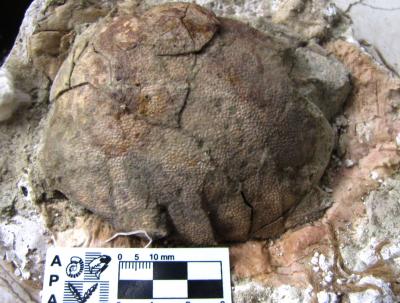 |
| One of the eggs of Bonapartenykus ultimus |
Now discoveries from Patagonia might offer clues as to the classification and temporal range of these enigmatic creatures. A team of Swedish and Argentinian palaeontologists excavating at 70 million year old rock found the remains of a small theropod dinosaur. It was a giant for its group, coming in at 2.6 metres in length, but what was more interesting were the two eggs close to the articulated bones of the hind limbs. This was the first time that eggs had been found near to an alvarezsaurid dinosaur.
The creature in question, a new species which was named Bonapartenykus ultimus after Jose Bonaparte, was dated to around 70 million years old, making it the youngest alvarezsaurid ever discovered. The eggs were found within the body cavity in areas which may have once been the oviducts. This suggested that the eggs had not been laid before the parent dinosaur died. Chemical analysis,on the other hand, showed high levels of calcite within the shell layer, indicating that they had been incubated; and that the embryos inside were at an advanced stage of development before death. In addition, the presence of small structures within the porous canals in the shell layer reveal that the eggs were subject to fungal contamination.
It is likely that the eggs had been laid and that the mother dinosaur sat on top of them to either incubate or protect them from predators before being overcome by a sandstorm or some other catastrophe. As more dinosaur species are discovered, we will gain greater insight into their relationships, lifestyle, and ultimately, what made these bizarre reptiles so successful for 170 million years.